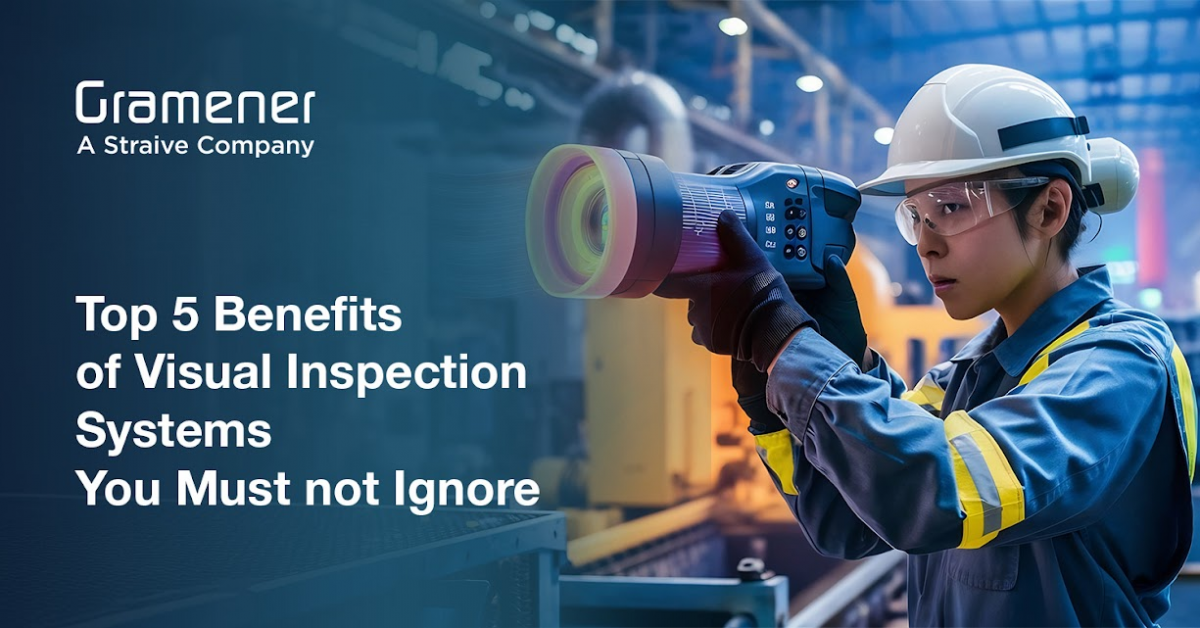Are you struggling with lengthy and labour-intensive processes of manual inspection at your manufacturing? You know these processes are prone to human error, which may cause severe quality issues in your products and increase your overall cost.
In today’s industrial, fast-paced landscape, precision cannot be compromised. A minor defect in a microchip or an automobile component can lead to costly recalls and damaged reputations. Conventional methods of inspection depend on human eyes or rule-based systems and often lack the speed and perfection that is required.
So, what is the right solution? We are introducing AI-powered visual inspection that combines computer vision and machine learning to detect defects with unprecedented accuracy, speed, and efficiency.
But what makes AI-based visual inspection the game-changer? Let’s explore its top benefits.
What is AI Visual Inspection?
Visual inspection is a technology that uses AI and computer vision to automate manufacturing processes. A vision inspection system consists of hardware and software elements that work together to provide precise quality control.
The hardware comprises cameras and sensors to take pictures, lighting systems to provide maximum visibility, and processing units (e.g., edge devices, GPUs, or cloud systems) to process the images.
The software element uses AI and machine learning algorithms to identify defects, computer vision models to identify anomalies, and data analytics tools to provide insights, enabling industries to achieve high-quality standards with precision and speed.
How Does AI Visual Inspection Work?
AI-powered visual inspection enhances quality control by using computer vision and deep learning to identify defects accurately. AI inspects assembly lines in minutes compared to traditional inspection, thus reducing errors and increasing efficiency. Machine learning algorithms scan images in real-time to ensure the products are up to specifications. Industry 4.0 enables cloud computing, which allows for real-time detection of defects in manufacturing, making it smarter and more dependable.
- Machine Learning and Computer Vision – The use of machine learning with past data enhances defect detection. Computer vision helps analyze images and interpret them for better inspection.
- Real-Time Image Processing – AI reads images in real time as items pass through the assembly line. It can detect defects immediately and correct them.
- Data Analysis and Decision-Making – AI evaluates defects, determines their severity, and forecasts potential future issues, allowing for better quality control and reliability.
Top 5 Benefits of Using AI for Visual Inspection in Industrial Automation
Want to know how AI for visual inspection can benefit your business at its best? Let’s look at it.
Improved Accuracy and Consistency
AI systems can identify even minute defects that human eyes might miss, providing consistent quality in each product.
Efficiency and Speed
AI-powered inspections process huge amounts of data in a short period, resulting in quick fault identification and minimized production cycles.
Cost savings
Automated inspections save labor costs and minimize rework or recall costs by identifying defects early.
Scalability
AI inspection systems can be developed to suit the needs of various industries and thus can be adopted by small businesses and large production units.
Improved Compliance and Reporting
AI systems provide detailed analytics, ensuring compliance with industry standards, easier patterns, and potential issue identification.
Do You Know?
- AI-powered visual inspection can change semiconductor manufacturing by improving the detection of defects while optimizing production efficiency.
According to McKinsey reports, AI/ML applications can reduce up to 17% of manufacturing costs, enhance yields and throughput, and make semiconductor production cost-effective and precise.
- AI systems can detect defects with up to 90% more accuracy than a human inspector, thereby producing a better-quality product
According to McKinsey, Highly autonomous vehicles are expected to make up 10 to 15% of global car sales in 2030, with expected two-digit annual growth rates by 2040.
Top 5 Sectors Leveraging AI for Visual Inspection
In a world where imperfections cost millions, AI-based visual inspection serves as the sharpest eye in the business, catching imperfections that would be impossible to catch with a human eye.
Whether in factories or food processing units, AI has become inevitable in perfecting precision and defining quality.
Automotive
Identifies defects in vehicle parts and ensures accurate assembly, thus preventing faulty components from reaching the market and enhancing overall vehicle safety.
Electronics
Detects faulty circuits and misaligned components, which reduces product failure and ensures reliability in devices such as smartphones, laptops, and semiconductors.
Food & Beverage
Ensures quality of products, integrity of packaging, and contamination detection, thence helping manufacturers meet safety regulations and maintain consumer confidence.
Pharmaceuticals
Check the packaging, labeling, and contamination risks. Ensure safe medication usage and adherence to regulatory compliance. Avert serious errors during medicine administration.
Manufacturing
Improve quality control and decrease the production of defective products by pointing out material defects, misalignment, and inconsistencies. This results in better efficiency and cost savings.
How Can We Help You Achieve Your Goals?
We at “Gramener”-A Straive Company use AI-powered computer vision that analyzes images captured from the production line to automate defect detection, thereby improving the quality control mechanism. Our system detects even minute issues and feeds back real-time information to your processes to optimize them.
Want to know more? Schedule a meeting with us.
